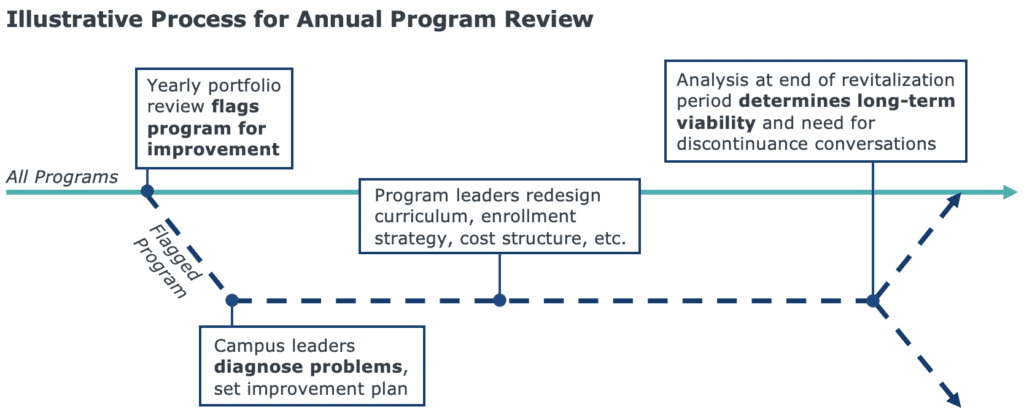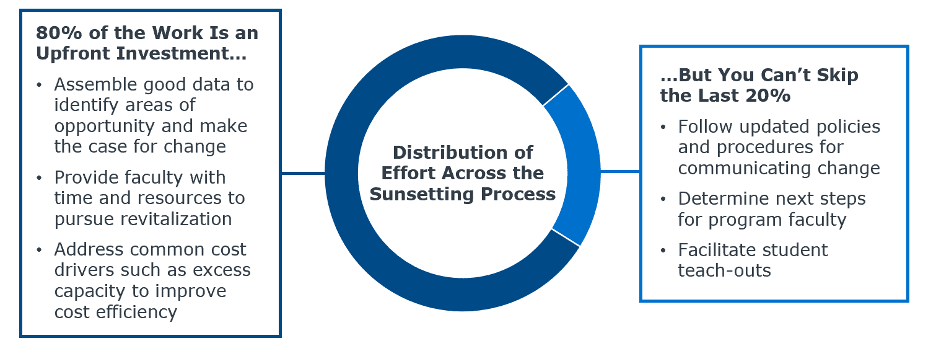Do you need to sunset academic programs? Consider these 3 steps.
As any faculty member or administrator will tell you, growing new programs is a lot easier than changing—or sunsetting—existing program offerings. As a former VPEM, and now in my role supporting university partners, I’ve seen just how tense conversations about sunsetting an academic program can become.
In our survey of presidents, provosts, and VPEMs, more than half of respondents said they increased their program offerings in the last year, compared to just 18% of respondents who decreased the number of offerings in their graduate and adult ed portfolios. But in an era of tightening budgets and slowing graduate and adult learner enrollment, university leaders need to have honest and sometimes difficult conversations about their program portfolios. Here are three best practices to consider as you navigate the process of right-sizing your graduate and adult program portfolio.
-
56%
of presidents, provosts, and VPEMs EAB surveyed in 2022 said they increased program offerings in the last year.
-
18%
of presidents, provosts, and VPEMs decreased the number of graduate and adult-serving programs in their portfolio.
CRAFTING COMPETITIVE GRADUATE AND ADULT-SERVING PROGRAMS
1. Regularly assess portfolio health using student, competitor, and labor market data
The first step to a successful portfolio assessment is making sure your team is analyzing the right data. From enrollment trends to revenue and expenses, faculty and instructional productivity, and student success rates, the sheer variety and volume of data available as part of the portfolio assessment process can be overwhelming.
Many of our Adult Learner Recruitment partners start with a portfolio health check, which looks at labor market intelligence data (including job postings in your primary and secondary markets and BLS projections) and competitive opportunity data (like number of and changes in degree conferrals and institutions offering competitor programs). Based on this data, our researchers assign each program in the portfolio a labor market demand score and a competitive opportunity score to help university leaders easily identify programs with the most and least opportunity relative to one another.
HERE’S HOW PRESIDENTS AND PROVOSTS ARE THINKING ABOUT THEIR GRADUATE PROGRAM PORTFOLIOS
Our Strategic Advisory Services team recommends taking a close look at your program portfolio annually. These conversations are a chance to address resource, curricular, and personnel questions on a regular basis. Annual portfolio reviews give you enough time to socialize any needed changes with faculty and allow you to intervene while there is still time to make a difference in a program’s performance. For more information on annual program review, see our Research team’s full study here.

2. Create a program watchlist—and give program leaders the guidance and parameters to improve
Once you’ve completed your annual review, you’re left with a list of programs that need further attention. This might mean redesigning program curriculum, rethinking the enrollment strategy, working on cost structure, and more. There is no one-size-fits-all playbook for fixing programs on your watchlist, as program health depends on so many factors, including those in the graphic below.

But there are a few guiding principles to empower program leaders, foster a culture of continuous improvement, and ensure watchlist programs get the attention they need in a timely manner.
- Make sure program leaders have the right data and resources to make program improvements. Consider data such as program enrollment trends, pipeline data, financial performance, student interest, and employer demand.
- Set a timeframe by which these improvements must occur—and make sure the expectations for what program improvement looks like are clear and quantifiable. For many institutions, two to three years is about when you should expect to see some changes in enrollment, student success, or other metrics. Some programs may show early signs of improvement but need more time to fully turn things around. That’s perfectly acceptable—but remember that keeping programs, resources, and faculty in limbo does not do the institution or students any favors.
3. Where possible, minimize stakeholder disruption and maximize cost savings
After taking the necessary steps to improve a program, and giving the program an appropriate amount of time to turn things around, you might decide it’s time to sunset the program. This process is often a difficult one for faculty and administrators. The good news: you’ve already done a lot of the heavy lifting by following steps 1 and 2 above.

At this stage, review institutional policies to ensure common faculty and student issues are addressed appropriately. In some conversations with university leaders, we’ve discovered that many institutions don’t have policies on program closures, financial exigency, and student teach-outs codified—or the policies are decades old. Where possible, encourage faculty who teach courses in programs to be sunset to collaborate across departments to create interdisciplinary studies programs. Enrollment in master’s-level interdisciplinary studies programs is on the rise. Most recently, enrollment in these programs grew 31% from 2021-2022.
The processes I’ve outlined here will look different based on your university’s mission, the markets in which you operate, and the unique challenges you’re facing. As you take a closer look at your program portfolio, lean into understanding your institutional market share, your competitor set, and student and market demand. And remember that optimizing your program portfolio is an ongoing process.

More Blogs

4 questions domestic students will ask before applying to your graduate program

When Grad PLUS disappears: What 8,000+ grad students said about paying for school
